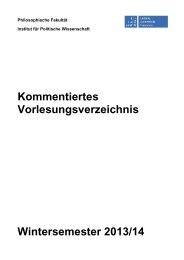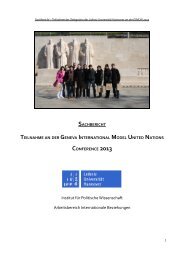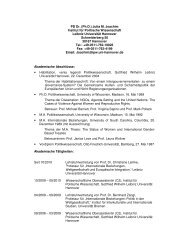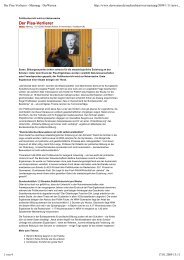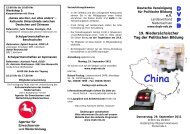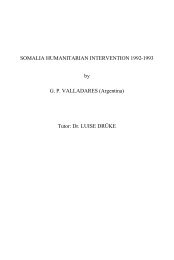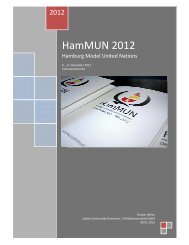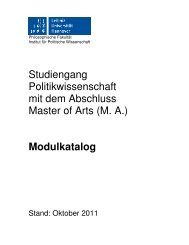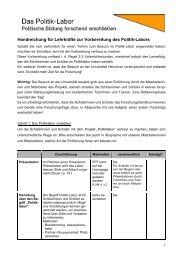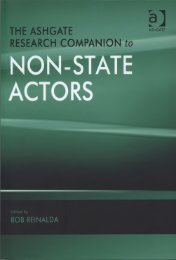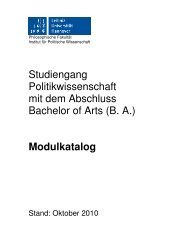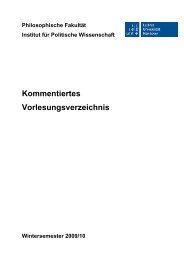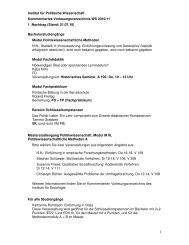Preventive Action for Refugee Producing Situations
Preventive Action for Refugee Producing Situations
Preventive Action for Refugee Producing Situations
Create successful ePaper yourself
Turn your PDF publications into a flip-book with our unique Google optimized e-Paper software.
122 Chapter 3<br />
which has encouraged large groups to spontaneously walk back, assisted by<br />
UNHCR if KISAN resisted it. 278<br />
Caught in the middle of tensions between different groups of people<br />
needing its protection, UNHCR moved to place those who wished to repatriate,<br />
or who were otherwise threatened by KISAN, in "protection houses"<br />
until their actual departure from the Mosquitia. On 28 May 1985 in Mocoron,<br />
I observed first-hand how the MISURA <strong>for</strong>ces attempted to kidnap the young<br />
males of the twelve repatriants directly out from under UNHCR protection<br />
officers when they were accompanying them to the airplane. A mission of the<br />
International Council <strong>for</strong> Voluntary Agencies (ICVA) concluded, "There are<br />
[still] pressures against successful return ... . [Nongovernmental] support of a<br />
successful repatriation of Miskitos and Sumo Indians can be the most valuable<br />
contribution to the pacification of the Atlantic Coast of Nicaragua.” 279<br />
In the fall of 1987, UNHCR initiated a more than $2 million project to help<br />
returnees on the Atlantic Coast of Nicaragua. The provision of funding by the<br />
European Economic Community and other European countries and agencies<br />
shows that now there is an implicit approval on the part of these donors <strong>for</strong><br />
improving conditions in the country of origin. With this backing and support,<br />
the prevention of voluntary repatriation will soon finally be able to come to an<br />
end. 280<br />
____________________<br />
278 Even though the refugees are adequately cared <strong>for</strong> in Honduras (although their<br />
presence there is used <strong>for</strong> various political and military purposes), an ICVA mis sion<br />
pointed out that <strong>for</strong> more and more refugees, the negative evaluation of refugee life<br />
plus the changes seen in Nicaragua over the past five years prompt them to go home.<br />
The UNHCR list of refugees interested in repatriation is longer than can be handled<br />
by the present staff. In addition, a representative of the Moravian Church in<br />
Managua told the mission that repatriation reflected a general desire to return to<br />
Nicaragua, saying that "the myth of fear has broken," that KISAN's propaganda was<br />
false, and expressing satisfaction with the autonomy law approved on April 24 1987<br />
in Puerta Cabeza. See Peplinski, and Diskin, "Report of the ICVA Mosquitia<br />
Mission," May 20-30,1987, p. 10-12.<br />
279 Peplinski and Diskin" Report of the ICVA Mosquitia Mission," 1987, p. 17.<br />
280 The rehabilitation project is to provide assistance to returnees on the Atlantic Coast<br />
of Nicaragua," (UNHCR Letter of Instruction of 17 September 1987) <strong>for</strong> transport<br />
and logistics, domestic needs and shelter, agricultural tools and equipment, and<br />
operational support through the Nicaraguan Institute of Social Security and Welfare<br />
(INSSBI), the Ministry of Constructions (MICONS), the Ministry of Housing and<br />
Settlement (MIDINRA), the Ministry of Health (MINSA), the Ministry of Education<br />
(MED), under the supervision of the UNHCR Charge de Mission <strong>for</strong> Nicaragua. The<br />
total expenditures from 1 August 1987 until 30 September 1988 are estimated at<br />
approximately $2,300,000. See UNHCR, "Special<br />
Analytical Discussion 123<br />
Forced recruitment by armed groups was also a recurrent problem in most<br />
refugee locations in the Mosquitia, both in Honduras and Nicaragua. During its<br />
mission in May 1987, the ICVA delegation found that the "movement toward<br />
repatriation competes with the ef<strong>for</strong>t to use this [refugee] population as a<br />
recruiting base <strong>for</strong> guerrilla warfare and to support the allegations of Sandinista<br />
repression."28i Cultural Survival also reports: "With the organization members<br />
deserting be<strong>for</strong>e their eyes, the KISAN leaders resorted to stongarm tactics to<br />
maintain themselves, including invading refugee camps, kidnapping Indian<br />
youths and conscripting them. " 282<br />
MIT Professor Martin Diskin has asserted that KISAN in particular has<br />
<strong>for</strong>cibly recruited Miskitos and taken reprisals against those who wished to<br />
remaln neutral. 283<br />
Even more serious incidents have occurred. In February 1987, a group of<br />
fifteen Sumos who had recently been repatriated to Nicaragua with UNHCR<br />
assistance was seized by an Indian contra group together with thirty other<br />
Sumos, as they were all traveling back to Musawas, their village of origin in<br />
Nicaragua. When the Indian contras attempted to convince the Sumos to return<br />
across the river to Honduras, thirty escaped. Another fifteen were taken armed<br />
guard, and were <strong>for</strong>ced to travel <strong>for</strong> four days up the Coco river to Rus Rus in<br />
Honduras. Three of this group, having obtained permission to visit relatives in<br />
the refugee camp at Tapalwas (an exclusively Sumo refugee village), did not<br />
return to fight. The contra group set out to recapture them, with the warning: "If<br />
[we] caught them in Nicaragua [we] would kill them. "284<br />
____________________<br />
Program Of Rehabilitation Assistance to Returnees of Indian Origin (Miskito and<br />
Sumo) on the Atlantic Coast of Nicaragua," (Draft), 25 July 1988.<br />
281 Peplinski and Diskin, "Report of the ICVA Mosquitia Mission, 1987, p. 10.<br />
282 Glenn T. Morris, "Between a Rock and a Hard Place - Left-Wing Revolution,<br />
Right-Wing Reaction and the Destruction of Indigenous People," Cultural Survival<br />
Quarterly 11, No. 3, (1987), p. 22.<br />
283 Diskin, "The Manipulation of Indigenous Struggles," p. 90.<br />
284 Americas Watch, "The Sumos in Nicaragua and Honduras: An Endangered<br />
People." (Washington, Septem D.C., September 1987), pp. 28 and 29. This document<br />
reported another <strong>for</strong>ced recruitment in March 1987, which ended in the murder<br />
of three resistors: On 28 March 1987, Palacios, an Indian Contra leader took<br />
35 Sumos from Nicaragua by <strong>for</strong>ce. The recruits were <strong>for</strong>ced on a 23-day march<br />
toward Ahuasbila in Honduras, when three of them, after refusing to continue,<br />
were said to have been executed. Fourteen of the remaining abductees were found<br />
at KISAN headquarters, and the rest managed to escape to the UNHCR refugee<br />
camp at Tapalwas, p.30. See also Americas Watch " Violations of the Laws of



